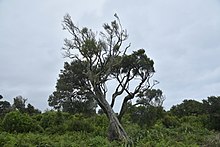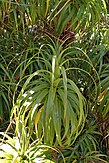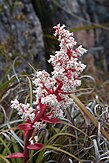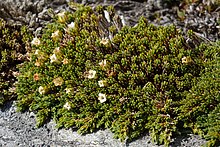Dracophyllum is a genus of plants belonging to the family Ericaceae, formerly Epacridaceae. There are 61 species in the genus, mostly shrubs, but also cushion plants and trees, found in New Zealand, Australia, Lord Howe Island and New Caledonia.[1] The name Dracophyllum, meaning dragon-leaf, refers to their strong outward similarity to the unrelated Dracaena, sometimes known as dragon tree. Although dicotyledonous, they resemble primitive monocots with their slender leaves concentrated in clumps at the ends of the branches; they are sometimes called grass-trees.
| Dracophyllum | |
|---|---|
| Clockwise from top: D. arboreum, D. milliganii, D. traversii, D. muscoides | |
| Scientific classification | |
| Kingdom: | Plantae |
| Clade: | Tracheophytes |
| Clade: | Angiosperms |
| Clade: | Eudicots |
| Clade: | Asterids |
| Order: | Ericales |
| Family: | Ericaceae |
| Subfamily: | Epacridoideae |
| Tribe: | Richeeae |
| Genus: | Dracophyllum Labill. |
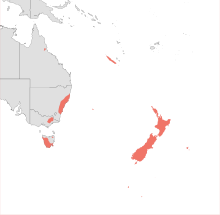
| |
| Approximate distribution
Range
| |
The height varies from one centimetre (D. minimum) to about 12 metres (D. longifolium).
Species
editThe following species are recognised by The Plant List:[2]
- Dracophyllum acerosum Berggr.
- Dracophyllum adamsii Petrie
- Dracophyllum alticola Däniker
- Dracophyllum arboreum Cockayne
- Dracophyllum × arcuatum W.R.B.Oliv.
- Dracophyllum balansae Virot
- Dracophyllum cosmelioides W.R.B.Oliv.
- Dracophyllum × densiflorum W.R.B.Oliv.
- Dracophyllum densum W.R.B.Oliv.
- Dracophyllum elegantissimum S.Venter
- Dracophyllum × erectum W.R.B.Oliv.
- Dracophyllum filifolium Hook.f.
- Dracophyllum fiordense W.R.B.Oliv.
- Dracophyllum fitzgeraldii C.Moore & F.Muell.
- Dracophyllum × insulare W.R.B.Oliv.
- Dracophyllum involucratum Brongn. & Gris
- Dracophyllum kirkii Berggr.
- Dracophyllum latifolium A.Cunn.
- Dracophyllum lessonianum A.Rich.
- Dracophyllum longifolium (J.R.Forst. & G.Forst.) R.Br. ex Roem. & Schult.
- Dracophyllum mackeeanum S.Venter
- Dracophyllum macranthum E.A.Br. & Streiber
- Dracophyllum × marginatum W.R.B.Oliv.
- Dracophyllum marmoricola S.Venter
- Dracophyllum matthewsii (Carse) Carse
- Dracophyllum menziesii Hook.f.
- Dracophyllum milliganii Hook.f.
- Dracophyllum minimum F.Muell.
- Dracophyllum muscoides Hook.f.
- Dracophyllum oceanicum E.A.Br. & Streiber
- Dracophyllum oliveri Du Rietz
- Dracophyllum ophioliticum S.Venter
- Dracophyllum ouaiemense Virot
- Dracophyllum paludosum Cockayne
- Dracophyllum palustre W.R.B.Oliv.
- Dracophyllum patens W.R.B.Oliv.
- Dracophyllum pearsonii Kirk
- Dracophyllum politum (Cheeseman) Cockayne
- Dracophyllum pronum W.R.B.Oliv.
- Dracophyllum prostratum Kirk
- Dracophyllum pubescens Cheeseman
- Dracophyllum pyramidale W.R.B.Oliv.
- Dracophyllum ramosum Pancher ex Brongn. & Gris
- Dracophyllum recurvum Hook.f.
- Dracophyllum rosmarinifolium (G.Forst.) R.Br.
- Dracophyllum × saxicola W.R.B.Oliv.
- Dracophyllum sayeri F.Muell.
- Dracophyllum scoparium Hook.f.
- Dracophyllum secundum R.Br.
- Dracophyllum sinclairii Cheeseman
- Dracophyllum strictum Hook.f.
- Dracophyllum subulatum Hook.f.
- Dracophyllum townsonii Cheeseman
- Dracophyllum traversii Hook.f.
- Dracophyllum trimorphum W.R.B.Oliv.
- Dracophyllum uniflorum Hook.f.
- Dracophyllum urvilleanum A.Rich.
- Dracophyllum × varium Colenso
- Dracophyllum verticillatum Labill.
- Dracophyllum viride W.R.B.Oliv.
- Dracophyllum × vulcanicum W.R.B.Oliv.
New Zealand
editAmong the New Zealand species (all of which are endemic)[1] are:
- D. arboreum, tarahinau or Chatham Island grass tree.[3] Tree-like growth to 10 m with a distinct juvenile phase, found in the Chatham Islands.
- D. acerosum, 2m tall shrub found in Southern Marlborough and Canterbury in the South Island.[4]
- D. densum, small shrub found on high mountain tops in the South Island.[5]
- D. elegantissimum, 14m tall tree found only in North-west Nelson in the South Island.[6]
- D. filifolium, 4m tall shrub / tree found in both the North and South Islands.[7]
- D. fiordense, western Otago and Fiordland
- D. kirkii, small shrub found in Canterbury and Westland in the South Island.[8]
- D. latifolium, neinei or spiderwood. Found in the North Island, from Mangonui southwards to North Taranaki and the Mahia Peninsula, growing from sea level to 1,100 m (Salmon 1973:271). Usually found growing under kauri.
- D. lessonianum, wi-wi. Although it can grow up to 10 m high, it most frequently is seen as a straggly shrub.
- D. longifolium, inanga or inaka. Growing to 12 m tall, this is the most widespread species in New Zealand, found from sea level up to 1200 m, in subalpine regions, from the middle of the North Island to as far south as the Auckland Islands.
- D. mathewsii, D. viride and D. sinclairii are found only in the far north of Tai Tokerau.
- D. marmoricola, 15cm tall prostrate shrub found in Kahurangi National Park in North-west Nelson.[9]
- D. menziesii is a multi-branched shrub that grows to 2 m. It grows in high rainfall areas in high montane to sub-alpine herbfields in Western Otago, Fiordland and Stewart Island / Rakiura.
- D. muscoides, small cushion found in the South Island.[9]
- D. oliveri, 1 - 4m tall shrub / tree found only in the South Island.[10]
- D. ophioliticum, 2m tall shrub found only in North-west Nelson.[5]
- D. palustre, 1m tall shrub found only on the west coast (region) of the South Island.[11]
- D. patens, 3m tall shrub / tree found only in the North Island.[12]
- D. pearsonii, 50cm tall shrub found in boggy and damp areas in the South Island.[13]
- D. politum, small cushion found from lowland to subalpine in the South Island.[9] Cushion-like grows up to 0.5m tall and 1m in diameter with small, narrow leaves covering the twigs. Blooms small white flowers from December to March. [14]
- D. prostratum, small prostrate shrub found in montane to subalpine areas in the South Island.[13]
- D. pronum, small shrub found in the South Island, mostly east of the Southern Alps[13]
- D. pubescens, small prostrate shrub found only in low alpine areas in North-west Nelson.[8]
- D. pyramidale, a very slender, almost fragile tree, growing up to 10 m high. Grows between Great Barrier Island and the Kaimai Range.
- D. recurvum, a 1m shrub with curled leaves, found in sub-alpine to high alpine regions of the Central Plateau of the North Island.
- D. rosmarinifolium, bushy 1m tall shrub found in both the North and South Islands.[4]
- D. scoparium, 4m tall shrub / tree found in the Chatham and Campbell Islands.[15] the species can extend its range to poorly drained area as a stunted shrub. Forms a hybrid swarm with D. longifolium. [16]
- D. sinclairii, 6m tall shrub / tree found only in the North Island.[17]
- D. strictum, 3m tall shrub / tree found only in coastal parts of the North Island.[18]
- D. subulatum, 2m tall shrub found in tussockland in central North Island.[19]
- D. townsonii, very similar to the neinei, grows mainly in the Nelson area and the West Coast of the South Island.
- D. traversii, mountain neinei. Growing to 13 m tall and found above 750 m in the top half of the South Island, also in scattered places in the North Island.
- D. trimorphum, 3m tall shrub / tree found only in North-west Nelson.[20]
- D. uniflorum (var. frondosum), 1m tall shrub found in the South Island.[21]
- D. uruvilleanum, 8m tall tree found only in the north half on the South Island (Marlborough and North-west Nelson).[10]
Australia
edit- D. sayeri grows near the summit of Mount Bellenden Ker Queensland's second highest peak.
- D. macranthum, restricted to the Landsdowne area near Taree on the NSW coast.
- D. secundum found in mountainous heath and sheltered lowland gullies on sandstone in the Sydney basin.
- D. oceanicum from seaside cliffs near Jervis Bay NSW.
- D. milliganii from the highlands of Tasmania
- D. minimum, cushion plant from Tasmanian mountains, also widespread in NZ.
Taxonomy
editDracophyllum is a genus in the family Ericaceae published by Labill in Voy. 2: 210. T. 40 (1798), with 61 species and 2 varieties. [22]
Dracophyllum has been found closely related to Richea and Sphenotoma, which are two genera endemic to south-eastern Australia and south-western Australia respectively. The three genera form a prominent clade in the strict consensus tree based on a molecular analysis by Crayn et al. in 1998. Traditionally, Dracophyllum is divided into three subgenera: subgenus Dracophyllum with 20 species found across New Zealand, Australia, Tasmania, Lord Howe Island, and New Caledonia; subgenus Cordophyllum with one species in New Caledonia; and subgenus Oreothamnus with 29 species in New Zealand and Tasmania. [23]
Brief History
editThe first two specimens of the genus Dracophyllum were collected by J.R. Forster and his son J. G. A. Forster in March 1773 in Fiordland, New Zealand and described as two different species Epacris longifolia (Dracophyllum longifolium) and Epacris rosmarinifolia (Dracophyllum rosmarinifolium). Now the genus Epacris is used to describe an endemic Australian genus of 40 species other than the one published by the Forsters.
In 1800, the genus name Dracophyllum was used for the first time by Labillardière to describe a plant specimen collected in New Caledonia. Ten years after the first Dracophyllum species was published, Robert Brown divided the genus into two subgenera: Dracophyllum and Sphenotoma based on some distinct morphological traits of corolla, stamens, bracts, and inflorescence. The first full description of the genus Dracophyllum was published by De Candolle in 1838 and was included in the family Epacrideae. In 1844, Hooker gave the first full descriptions of the species and the species relationships, mentioning that Sphenotoma had been raised to genus level by Sweet in 1827. A century later, Dracophyllum (as Eudracophyllum), Oreothamnus had been raised to subgenus level and Cordophyllum was described as a third subgenus by Oliver in 1928. Sphenotoma was removed from the genus. [23]
References
edit- ^ a b Eagle, Audrey (2006). Eagle's complete trees and shrubs of New Zealand. New Zealand: Te Papa Press. p. 564. ISBN 0-909010-08-0.
- ^ "Dracophyllum". The Plant List. Retrieved 17 February 2016.
- ^ "Dracophyllum arboreum | New Zealand Plant Conservation Network". www.nzpcn.org.nz. Retrieved 2019-09-02.
- ^ a b Eagle, Audrey Lily (2006). Eagle's complete trees and shrubs of New Zealand. Wellington, N.Z.: Te Papa Press. p. 602. ISBN 978-0-909010-08-9. OCLC 85262201.
- ^ a b Eagle, Audrey (2006). Eagle's complete trees and shrubs of New Zealand. New Zealand: Te Papa Press. p. 582. ISBN 0-909010-08-0.
- ^ Eagle, Audrey (2006). Eagle's complete trees and shrubs of New Zealand. New Zealand: Te Papa Press. p. 570. ISBN 0-909010-08-0.
- ^ Eagle, Audrey (2006). Eagle's complete trees and shrubs of New Zealand. New Zealand: Te Papa Press. p. 574. ISBN 0-909010-08-0.
- ^ a b Eagle, Audrey Lily (2006). Eagle's complete trees and shrubs of New Zealand. Wellington, N.Z.: Te Papa Press. p. 608. ISBN 978-0-909010-08-9. OCLC 85262201.
- ^ a b c Eagle, Audrey Lily (2006). Eagle's complete trees and shrubs of New Zealand. Wellington, N.Z.: Te Papa Press. p. 612. ISBN 978-0-909010-08-9. OCLC 85262201.
- ^ a b Eagle, Audrey Lily. (2006). Eagle's complete trees and shrubs of New Zealand. Eagle, Audrey Lily., Eagle, Audrey Lily. Wellington, N.Z.: Te Papa Press. p. 598. ISBN 978-0-909010-08-9. OCLC 85262201.
- ^ Eagle, Audrey (2006). Eagle's complete trees and shrubs of New Zealand. New Zealand: Te Papa Press. p. 590. ISBN 0-909010-08-0.
- ^ Eagle, Audrey (2006). Eagle's complete trees and shrubs of New Zealand. New Zealand: Te Papa Press. p. 596. ISBN 0-909010-08-0.
- ^ a b c Eagle, Audrey Lily (2006). Eagle's complete trees and shrubs of New Zealand. Wellington, N.Z.: Te Papa Press. p. 614. ISBN 978-0-909010-08-9. OCLC 85262201.
- ^ "Dracophyllum politum". New Zealand Plant Conservation Network. Retrieved 2021-02-18.
- ^ Eagle, Audrey Lily. (2006). Eagle's complete trees and shrubs of New Zealand. Wellington, N.Z.: Te Papa Press. p. 604. ISBN 978-0-909010-08-9. OCLC 85262201.
- ^ Bestic, Kim L.; Duncan, Richard P.; McGlone, Matt S.; Wilmshurst, Janet M.; Meurk, Colin D. (2005). "Population age structure and recent Dracophyllum spread on subantarctic Campbell Island". New Zealand Journal of Ecology. 29 (2): 291–297. ISSN 0110-6465. JSTOR 24058185.
- ^ Eagle, Audrey (2006). Eagle's complete trees and shrubs of New Zealand. New Zealand: Te Papa Press. p. 584. ISBN 0-909010-08-0.
- ^ Eagle, Audrey (2006). Eagle's complete trees and shrubs of New Zealand. New Zealand: Te Papa Press. p. 592. ISBN 0-909010-08-0.
- ^ Eagle, Audrey Lily (2006). Eagle's complete trees and shrubs of New Zealand. Wellington, N.Z.: Te Papa Press. p. 606. ISBN 978-0-909010-08-9. OCLC 85262201.
- ^ Eagle, Audrey (2006). Eagle's complete trees and shrubs of New Zealand. New Zealand: Te Papa Press. p. 578. ISBN 0-909010-08-0.
- ^ Eagle, Audrey (2006). Eagle's complete trees and shrubs of New Zealand. Wellington, N.Z.: Te Papa Press. p. 600. ISBN 978-0-909010-08-9. OCLC 85262201.
- ^ "Dracophyllum Labill". COL. Archived from the original on 2021-06-10. Retrieved 2021-02-18.
- ^ a b Venter, Stephanus (2009). A Taxonomic Revision of the Genus Dracophyllum Labill. (Ericaceae) (PhD). Victoria University of Wellington.
- Brown, E.A.; Streiber, N. (1999). "Systematic studies in Dracophyllum (Epacridaceae) 2. New species of Dracophyllum in New South Wales" (PDF). Telopea. 8 (3): 393–401. doi:10.7751/telopea19995429. Archived from the original (PDF) on 30 July 2008.
- Poole, A.L. (1966). "Dracophyllum Species". In Mclintock, A.H. (ed.). An Encyclopaedia of New Zealand. Vol. 1 A–H. OCLC 163126463.
- Venter, S. (2002). "Dracophyllum marmoricola and Dracophyllum ophioliticum (Ericaceae), two new species from north-west Nelson, New Zealand". New Zealand Journal of Botany. 40 (1): 39–47. Bibcode:2002NZJB...40...39V. doi:10.1080/0028825X.2002.9512769. S2CID 84635580.
- Venter, S. (2004). "Dracophyllum mackeeanum (Ericaceae: Richeeae), a new species from New Caledonia". New Zealand Journal of Botany. 42 (5): 747–751. Bibcode:2004NZJB...42..747V. doi:10.1080/0028825X.2004.9512928.
- Salmon, J.T. (1973). The Native Trees of New Zealand. Wellington, New Zealand: A.H. & A.W. Reed. ISBN 0-589-01340-8.
